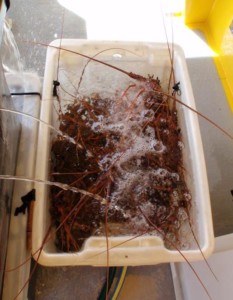Privacy Notice
This website uses cookies to improve your experience. Read our Privacy Policy to learn more.
Recently we talked about dissolved oxygen and why it’s important for your lobsters. In this edition we discuss on board holding system water flow requirements and how to measure live tank flow rates on your boat.
Water flow seems pretty easy, right? Water in and water out = happy lobsters, but this isn’t always the case. Flow through on board holding tanks must provide a suitable environment that satisfies the lobster’s physiological requirements to maintain the premium quality you’re striving for. Remember, just because you can see water flowing out of a tank doesn’t necessary mean the flow rate is adequate, or that the water is evenly moving through all areas of the tank.
Lobster size, stocking density, feeding and activity and water temperature all influence the water flow needed to provide a suitable live holding environment, and we recommend you have your system set up for the worst case scenario to cover all eventualities.
As discussed in a previous Brolos Catcher, dissolved oxygen (DO) is one of the most important water quality parameters when holding live lobsters and we set water flow rates with DO as the priority. For on board holding systems WITHOUT aeration, a good rule of thumb to operate with is a flow rate of 1.0 L of seawater/kg of lobster/minute. This number is based on holding fed, active lobsters at 23°C and is required to maintain sufficient oxygen levels for lobsters all the way to the point at which water leaves the system. For on board holding systems WITH aeration, it’s assumed the aeration is providing sufficient oxygen, therefore the next major water quality parameter that needs to be controlled via adequate water flow is the accumulation of toxic ammonia excreted by the lobsters. The required flow rate to ensure ammonia does not accumulate is 0.22 L of seawater/kg of lobster/minute.
For example, if you have a 24 basket tank on the boat without aeration, assuming each basket holds an average of 27 kg of lobster and water flow is perfectly distributed, you would need 24 baskets x 27 kg each x 1 L seawater/min = 648 L/min flowing through that tank. If the tank is aerated, you would only need (24 baskets x 27 kg each x 0.22 L seawater/min = 142.6 L/min. Note these figures are for constant flow rates. Any variable output, rev-driven pump is not considered suitable for an on board live holding system.
Measuring water flow rates on your boat is quite simple, but there are a few tips to be aware of. The best way to calculate a flow rate is to time how long it takes to fill the top portion (say the top 10 cm) of the tank. This method accounts for the increased head pressure on the pump due to the depth of the tank and allows the pump to be running at full flow when you begin timing. Remove all the baskets and with the tank full and pump running normally, make a mark on the sidewall of the tank at the water surface. Empty the tank and make another mark that is 10 cm below the first mark. Start the pump and when the water level hits the bottom mark start your stopwatch. Stop timing when the water level hits the top mark.
Going back to our 24 basket tank used in the example above, let’s assume it’s 3 baskets deep by 8 long and measures 60 cm wide x 320 cm long, to calculate the volume of the top 10 cm of the tank, multiply (60 cm wide x 320 cm long x 10 cm deep) ÷ 1000 = 192 L. At the required flow rate of 648 L/min for an unaerated set up, it will take 192 L ÷ 648 L/min x 60 sec = ~18 seconds to fill the top 10 cm of this tank.
Just remember an adequate flow rate is only part of the puzzle. In addition to having sufficient flow, the tank must be designed to distribute water evenly and to force the water through the lobsters. One of the most common issues we see is where tanks have really high flow rates, but the water goes around the baskets, leaving the lobsters in the middle of the baskets in stagnant, poorly oxygenated water. Water inlets and outlets should be as far apart as possible, with an upwelling flow direction to maximise the time your lobsters have to utilise incoming clean, oxygenated water. Baskets should fit tightly within the tanks to force the water through the lobsters, rather than allowing it to flow around the edges where lobsters can’t benefit from the vital oxygen it carries.
Good luck assessing your current systems and please contact GFC Research and Development Officer, Joel Durell (0407 135 712) or GFC Continuous Improvement Manager, Brad Armstrong (0437 513 837) if you would like any assistance on taking the next step in your quality journey.
Figure: Without measuring, it’s very difficult to tell if your lobsters are getting sufficient water flow to keep them in premium condition
